10 Best Trail Cameras in Canada in 2024 — Reviews & Top Picks
Last Updated on
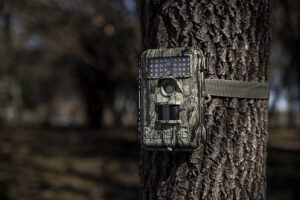
Trail cameras, also known as game or wildlife cameras, come in handy for hunters or people who enjoy watching and keeping track of wildlife on their property. The kind of camera that you should invest in will depend on what you want to use it for. But there are several cameras to choose from with many different features, so how do you pick the right one?
We looked through the trail cameras available to Canadians and created reviews so you can become more familiar with this kind of technology. The buyer’s guide also has a few pointers for finding the right trail camera for your needs.

A Quick Glance at Our Favourites in 2024
| Image | Product | Details | ||
|---|---|---|---|---|
| Best Overall |
 |
GardePro A3 Trail Camera |
|
CHECK PRICE |
| Best Value |
 |
Vanbar Trail Camera |
|
CHECK PRICE |
| Premium Choice |
 |
Tactacam Reveal X Cellular Trail Camera |
|
CHECK PRICE |
 |
Zopu Trail Camera |
|
CHECK PRICE | |
 |
Bushnell Trophy Trail Camera |
|
CHECK PRICE |
The 10 Best Trail Cameras in Canada
1. GardePro A3 Trail Camera — Best Overall
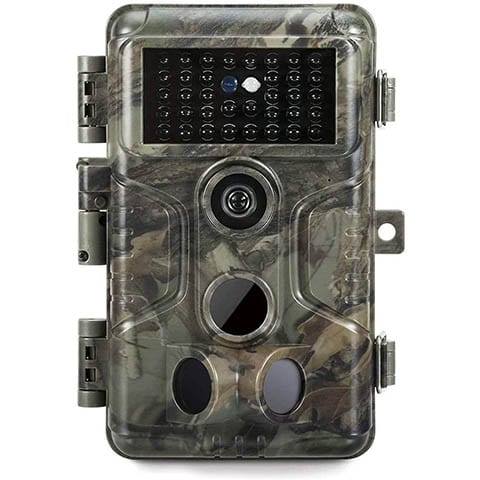
| Video resolution: | 1080p |
| Trigger speed: | 1 seconds |
| Wireless: | No |
| Detection range: | 82 feet |
The best overall trail camera in Canada is the GardePro A3 Trail Camera. It’s reasonably priced and works quite well in low-light conditions, particularly for night vision. It has a large aperture lens for crisp images. It uses no-glow technology, which will also give you clear pictures at night but without any kind of flash that will spook the animals. The night vision has a 100-foot range, records with sound (not always a standard feature for these kinds of cameras), and has clear playback. The video features high-resolution 1080p, and the camera has a compact file size that uses as much as 80% less storage than other comparable cameras. It also features a fast trigger speed of 0.1 seconds, a 0.5-second recovery time, and an 82-foot detection distance.
The issues with this camera are that it doesn’t have wireless, so you’ll need an SD card to watch the footage. Also, the batteries tend to drain quickly.
- Affordable
- Uses no-glow technology
- Night vision has 100-foot range
- Records high-resolution 1080p video with sound
- Lightning-fast trigger speed and recovery time
- Not wireless
- Batteries might drain quickly
2. Vanbar Trail Camera — Best Value

| Video resolution: | 1080p |
| Trigger speed: | 2 seconds |
| Wireless: | No |
| Detection range: | 65 feet |
The best trail camera in Canada for the money is the Vanbar Trail Camera. Not only is it affordable, but it also has a 0.2-second trigger when it detects motion, even at night. It uses low-glow infrared, which gives you clear night vision. It uses 120-degree wide-detection angles and is high resolution at 1080p. It’s waterproof, so the lens shouldn’t have any moisture issues. The company also provides a 30-day refund policy.
The problems here are that it isn’t always reliable — sometimes it takes video and sometimes only photos. Additionally, it requires a micro-SD card, which means you’ll also need a card reader.
- Well-priced
- 2-second trigger
- Low-glow infrared for night vision
- Uses 120-degree wide detection
- 30-day refund policy
- Not always reliable
- Only uses a micro-SD card
3. Tactacam Reveal X Cellular Trail Camera — Premium Choice
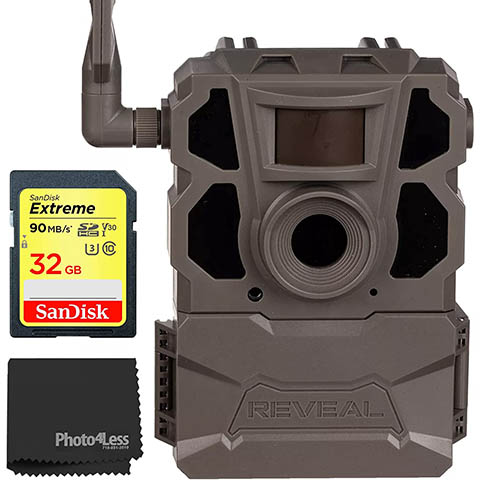
| Video resolution: | 720p |
| Trigger speed: | 1/2 seconds |
| Wireless: | Yes |
| Detection range: | 96 feet |
The Tactacam Reveal X Cellular Trail Camera is our premium choice pick. It has a fast trigger of .5 seconds and uses low-glow infrared for taking clear pictures without frightening the animals with a flash. Other than taking high-quality photos, one of the best features of this trail camera is that it uses cellular service, which means you can connect to the camera wirelessly. You can use the app for setup and live viewing on your phone, and it also shows the battery levels and signal strength.
The cons are that it is expensive, and if there’s an issue with the camera, customer service isn’t always reliable.
- .5-second trigger
- Low-glow infrared for night pictures
- Wireless access with the app
- App shows battery strength and live view options
- Expensive
- Customer service is not always reliable
4. Zopu Trail Camera

| Video resolution: | 1296p |
| Trigger speed: | 2–0.6 seconds |
| Wireless: | No |
| Detection range: | 82 feet |
The Zopu Trail Camera is quite affordable and has high-resolution 1296p video and 24mp for clear pictures. The video also records sound and uses no-glow infrared for great photos, even in total darkness. The flash reaches up to 75 feet. It is designed to withstand most weather extremes and is waterproof, dustproof, and drop proof. It boasts a long battery life when in standby mode.
However, it can be inconsistent with detecting movement, and the battery life isn’t always as good as stated.
- Well-priced
- High resolution at 1296p and 24mp for photos
- Video records sound
- Waterproof and drop proof and works in weather extremes
- Inconsistent in detecting movement
- Battery life not as good as expected
5. Bushnell Trophy Trail Camera
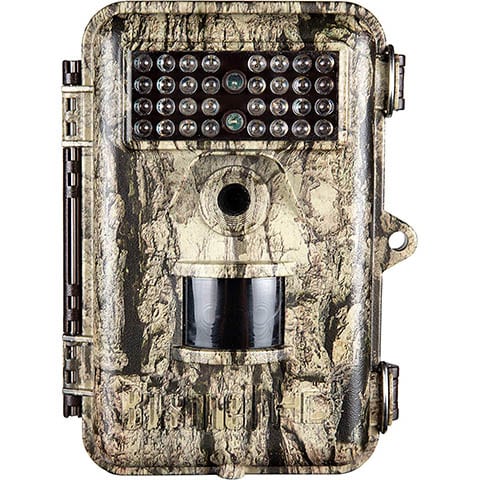
| Video resolution: | 720p |
| Trigger speed: | 7 seconds |
| Wireless: | No |
| Detection range: | 80 feet |
Bushnell’s Trophy Trail Camera has features that can come in handy while tracking wildlife. It has date, time, and temperature stamps for accurate information. You can also program the trigger interval in addition to the video resolution and length and whether you want multi-image mode. Bushnell also provides you with the option to select the quality of the images, which can be set to 3, 8, or 20mp, so they can be as crisp as you want. The camera is quite hardy and can withstand all kinds of weather conditions.
The flaws, however, are that the field of vision is fairly narrow because it doesn’t offer widescreen options, and the night-vision photos aren’t always clear.
- Date, time, and temperature stamps
- Program multi-image mode and video resolution and length
- Hardy in different weather conditions
- Choose image quality (3, 8, or 20mp)
- Narrow field of vision (no widescreen)
- Night-vision images are not always clear
6. WingHome Trail Camera
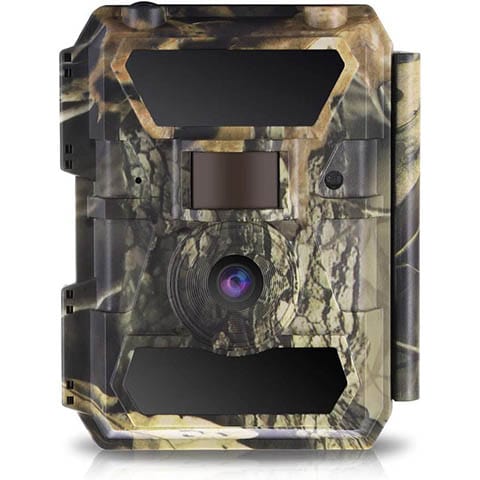
| Video resolution: | 1080p |
| Trigger speed: | 3 seconds |
| Wireless: | No |
| Detection range: | 65 feet |
WingHome’s Trail Camera has photo quality options for 12, 16, or 22mp, as well as 1080p video for up to 1 minute in length. It has no-glow LED night vision and a 100-degree viewing angle, so you don’t need to worry about your images having a fish-eye distortion. It has a super-fast trigger speed of 0.3 seconds and a 65-foot detection range, and it records with sound. It is sturdy, easy to open, and compatible with power adapters and solar panels.
The problems with this camera are that the photos aren’t always as clear as they should be, particularly at night, and some of these cameras don’t last longer than a year.
- Records 1080p 1-minute video with sound
- No-glow LED night vision
- 100-degree view, no fish-eye distortion
- 3-second trigger
- Compatible with power adapter and solar panel
- Pictures are not always clear
- Doesn’t always last for more than 1 year
7. Stealth Cam Trail Camera
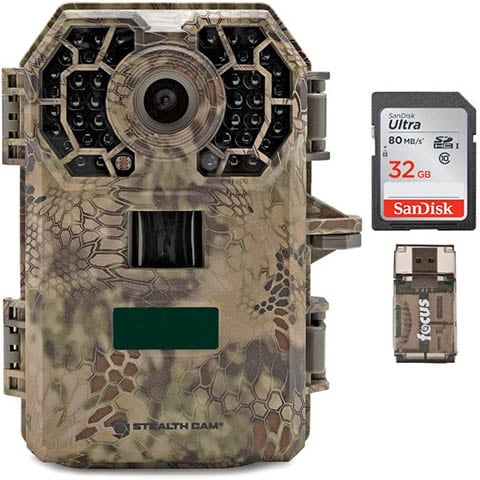
| Video resolution: | 480p, 720p |
| Trigger speed: | 8 seconds |
| Wireless: | No |
| Detection range: | 100 feet |
Stealth Cam’s Trail Camera captures high-quality 24mp photos and HD video in either 480p or 720p. For night photos, it uses infrared that is activated at 100 feet and records the date, temperature, and moon phase. It comes with a 32-GB SD memory card and a USB 2.0 card reader. The field of view can reach 16:9 wide and captures one to nine exposures when triggered. It uses GPS for tagging.
The problems with this camera are that it doesn’t always take clear pictures when the animal is at a distance, and the video only records approximately 10 seconds of footage.
- High-quality 24mp photos
- Infrared activated at 100 feet
- 32-GB SD memory card and 2.0 card reader included
- 16:9 wide field of view
- Pictures tend to be blurry at a distance
- Video only records about 10 seconds
8. Cuddeback H-1435 Trail Camera
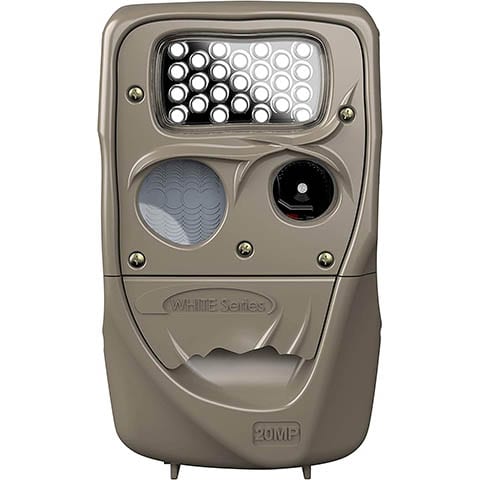
| Video resolution: | 20mp |
| Trigger speed: | ¼ seconds |
| Wireless: | No |
| Detection range: | 100 feet |
The Cuddeback H-1435 Trail Camera has 20mp for screen captures and a ¼ trigger speed. It only requires about 1 second of recovery before taking the next shot. It uses infrared for night pictures, which just shows a slight red glow and can detect movement at around 100 feet. The sensor uses a wide angle to capture motion, and the settings are quite easy and intuitive to follow.
However, the trigger can be unreliable in some cameras, so it doesn’t always capture movement. Also, the quality of the photos, particularly at night, is sometimes not great.
- ¼ trigger speed
- 20mp for screen capture
- 1-second recovery time
- Detects movement at 100 feet and at a wide angle
- Trigger can be unreliable
- Night pictures are not always good quality
9. Meidase Trail Camera
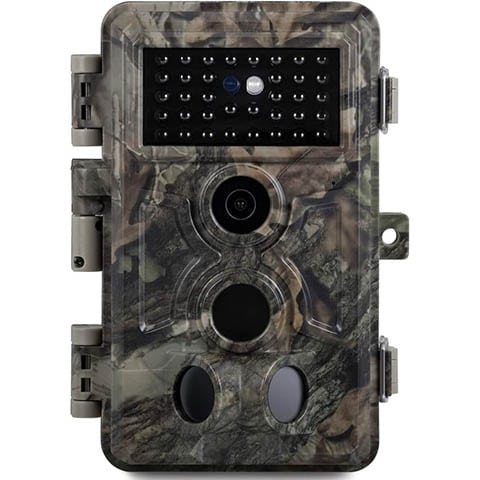
| Video resolution: | 1296p |
| Trigger speed: | 2 seconds |
| Wireless: | No |
| Detection range: | 82 feet |
The Meidase Trail Camera has high-quality HD video at 1296p and includes a sensitive microphone for sound. It has a 0.2-second trigger speed for movement within a 120-degree wide angle at 82 feet. It is waterproof and has a long battery life of 8 months when in standby mode. The night vision is enhanced with no-glow infrared technology.
The flaws here are that it’s not always reliable — some cameras might take pictures of nothing, while others don’t take photos at all. Plus, some of the cameras tend to use up batteries quickly.
- 1296p video records sound
- 2 trigger speed for 120-degree detection angle
- 8-month battery life in standby
- No-glow infrared
- Some cameras are unreliable
- Might drain batteries quickly
10. BlazeVideo Wifi Trail Camera
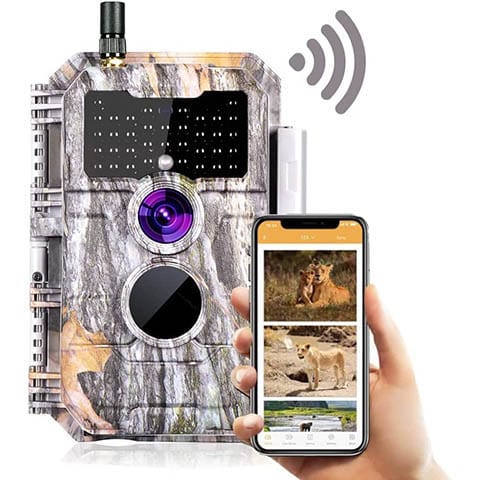
| Video resolution: | 1296p |
| Trigger speed: | 5 seconds |
| Wireless: | Yes |
| Detection range: | 75 feet |
The BlazeVideo Wifi Trail Camera has a high-quality resolution for photos (24mp) and video (1296p). It has a 110-degree view angle to capture movement and the added advantage of wireless capability. Once the app is downloaded to your phone, you can set up the camera and have footage sent straight to the app. It also has no-glow night vision for up to 75 feet.
The cons with this camera start with the fact that it doesn’t have sound, and if you live in a particularly rainy part of the world, water might leak in. Additionally, the instructions aren’t that clear.
- 24mp for photos and 1296p for video
- 110-degree view angle
- App available for easy setup and viewable footage
- No-glow night vision
- No sound
- Not effectively waterproof
- Instructions not clear
Buyer’s Guide
To help in your camera decision, this buyer’s guide goes over a few points for you to consider before making your final choice.
The Kind of Camera
If you’re interested in high-quality video and pictures, you’ll want a camera with the highest resolution, such as 1080p. If you just want to keep an eye on your property, you won’t necessarily need all the bells and whistles, as these will significantly increase the price. Always read the reviews — the good and the bad — because they can give you extra information from buyers.
The Necessities
Keep in mind that most trail cameras require batteries and memory cards, which are not always included with the camera. Always read the fine print, and ensure that you have any additional items that the camera needs, like the right kind of batteries and memory cards. Lithium batteries are recommended. If you’re looking for a trail camera that includes sound or has wireless capabilities, be sure to read the description carefully and read the reviews. Sometimes the descriptions are inaccurate, and you can learn more from actual customer reviews.
Technical Specs
If you’re not familiar with the technical descriptions of cameras and what it all means, here are a few terms to help you have a better understanding of the jargon:
- Trigger speed: This is how fast the camera reacts to movement and takes pictures and/or video. The wider the angle, the sooner the camera will be triggered.
- Recovery time: This is the time between when the camera takes a picture and how soon it’s able to take another. This is more of an issue with nighttime photos because the flash takes more juice.
- Detection range: This tells you how far away the camera can detect movement to trigger a video or photo. The wider the angle, the faster it will detect motion.
- MP: This stands for megapixels, which is the number of pixels that the sensor has. The higher the MP, the higher quality the pictures are.
- Flash range: This is how far the flash will reach to light up the subject. A short-range flash means that the animal needs to be up close for you to get a good picture of it.
- Low glow: This is when the camera will emit a “low glow,” which is often red and doesn’t typically bother wildlife. But if you’re detecting people, do know that this will make the camera stand out at night.
- No glow: The camera uses infrared that is not visible to animals or people. The drawback is that it can only take black-and-white pictures.

Conclusion
Our favorite trail camera overall is the GardePro A3 Trail Camera, which has one of the fastest trigger responses at 0.1 seconds. The Vanbar Trail Camera is affordable and has a 120-degree-wide detection angle and 1080p resolution. Finally, the Tactacam Reveal X Cellular Trail Camera is our premium choice pick for its use of Wi-Fi and app for easy setup and live viewing on your phone.
We hope that these reviews have helped you pinpoint the perfect trail camera for your needs. Watching wildlife and the goings-on in your backyard can be fascinating!
See also:
Table of Contents
- A Quick Glance at Our Favourites in 2024
- The 10 Best Trail Cameras in Canada
- 1. GardePro A3 Trail Camera — Best Overall
- 2. Vanbar Trail Camera — Best Value
- 3. Tactacam Reveal X Cellular Trail Camera — Premium Choice
- 4. Zopu Trail Camera
- 5. Bushnell Trophy Trail Camera
- 6. WingHome Trail Camera
- 7. Stealth Cam Trail Camera
- 8. Cuddeback H-1435 Trail Camera
- 9. Meidase Trail Camera
- 10. BlazeVideo Wifi Trail Camera
- Buyer’s Guide
- Conclusion
About the Author Kathryn Copeland
Kathryn was a librarian in a previous lifetime and is currently a writer about all things birds. When she was a child, thanks to her love of animals she hoped to work in zoos or with wildlife in some way. She's not strong in the sciences, unfortunately, so she uses her time to research and write about all kinds of birds and animals, and hopes to bring that detailed knowledge to OpticsMag.
Related Articles:
How to Clean a Refractor Telescope: Step-by-Step Guide
How to Clean a Telescope Eyepiece: Step-by-Step Guide
How to Clean a Rifle Scope: 8 Expert Tips
Monocular vs Telescope: Differences Explained (With Pictures)
What Is a Monocular Used For? 8 Common Functions
How to Clean a Telescope Mirror: 8 Expert Tips
Brightfield vs Phase Contrast Microscopy: The Differences Explained
SkyCamHD Drone Review: Pros, Cons, FAQ, & Verdict



